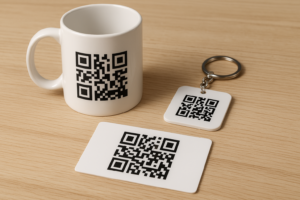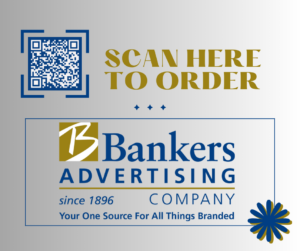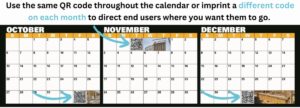By: Sarah Loula
I recently received a wedding invitation that included a QR code for RSVPs. Scanning it led me to a form where I could enter my name, list additional guests, select food preferences, and even view the wedding registry. I thought this was a fantastic experience for both sides! As a guest, I had all the information I needed in one spot, and my cousin, the bride, could easily access all the details she needed to plan her wedding smoothly. It was a win-win!
In today’s fast-evolving marketing landscape, QR codes have become a powerful tool for bridging the gap between physical products and digital experiences. Incorporating QR codes into promotional products not only enhances engagement but also offers a measurable way to track interactions. Here are five creative ways to integrate QR codes into your promotional merchandise strategy:
1. Interactive Product Tutorials
QR codes can turn ordinary promotional items into engaging, interactive tools. For example, if you’re giving away branded kitchen utensils, include a QR code that links to cooking tutorials or recipe videos. This added value will make customers more likely to keep the product.
Example: A branded water bottle with a QR code that leads to hydration tips, workout routines, or sustainability advice can build a deeper connection with the consumer.
2. Exclusive Discounts and Promotions
QR codes are a great way to unlock special discounts or offers. By scanning the code, customers can access exclusive deals, seasonal discounts, or loyalty rewards directly through your website or app. This strategy encourages repeat purchases while driving conversions.
Example: A branded tote bag with a QR code leading to a 10% off coupon for a future purchase can encourage users to return to your store.
3. Gamified Experiences and Contests
Gamification is an effective way to boost engagement. Add a QR code that directs users to a contest entry form, a digital scratch-off game, or a trivia challenge. This approach is especially effective at trade shows, events, or product launches.
Example: A custom T-shirt featuring a QR code that unlocks a “spin-the-wheel” prize drawing encourages instant interaction and brand recall.
4. Instant Access to Digital Business Cards
Networking events present an excellent opportunity to integrate QR codes. Instead of handing out traditional business cards, promotional items like keychains, pens, or notebooks can feature QR codes that link directly to your digital business card or LinkedIn profile. This method is eco-friendly, memorable, and convenient for busy professionals.
Example: A sleek, branded notebook with a QR code inside the front cover linking to your digital profile makes networking efficient and impactful.
5. Personalized Experiences
Consumers love personalized experiences. By adding QR codes that lead to tailored content, brands can create meaningful connections. For example, QR codes can link to thank-you videos, personalized recommendations, or customized landing pages with the recipient’s name.
Example: Adding a QR code to a calendar enhances its functionality, access to company information, and user experience, while also offering a cost-effective brand builder.
Tips for Maximizing QR Code Effectiveness:
- Design Thoughtfully: Ensure QR codes blend seamlessly with your product’s design, while still being noticeable and easy to scan.
- Add a Call-to-Action (CTA): Include clear instructions like “Scan for a Special Offer” to guide users.
- Track and Analyze: Use dynamic QR codes to track scans, measure engagement, and update content without reprinting the code.
By integrating QR codes into promotional products creatively and functionally, businesses can build stronger connections with their audience, enhance brand visibility, and achieve measurable results. With the right strategy, QR codes can elevate even the simplest items into powerful marketing tools.



